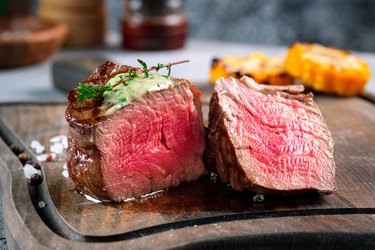
Any piece of beef can vary widely in tenderness, depending on the age of the animal and how it was fed, so cuts that are reliably tender are valued highly. The tenderest of them all is the tenderloin, often referred to on menus by the French term "filet mignon." Some restaurants and butchers confuse the issue, by offering the choice of single-cut or double-cut filets. This simply refers to the thickness and weight of the portions.
The Whole Filet
Video of the Day
The whole tenderloin, or filet, is an arm-sized muscle found underneath the animal's spine. The loin itself is directly above, on the other side of the bones, and the two are cut together with the bone to make porterhouse or T-bone steaks. When the loin is separated for use as a tenderloin, it takes the shape of a long and slightly tapered cylinder. The thick end of the tenderloin and its barrel-shaped middle, where the size is most consistent, can be used as a roast or cut into relatively large medallions called tournedos.
Video of the Day
The Little Filet Mignon
In French culinary terminology, the whole tenderloin is referred to as the filet, and filet mignon simply means "little filet," or portions cut from the smaller end. They begin at the point where the tenderloin begins to taper, and stop when it becomes too small to make a suitable portion. A typical single-cut filet ranges from 1 1/4 inch to 1 3/4 inch in height, and weighs 3 to 6 ounces. A portion often consists of two of these small medallions.
A double-cut filet is cut 2 inches or more in height, and can weigh 8 to 12 ounces. They're prepared similarly, though double-cut filets require more careful handling.
Cooking and Time
Most premium steaks are well marbled with fat, but the filet is an exception. It's extremely lean, which means it can easily dry out and become tough if it's overcooked. It also requires slightly lower cooking temperature than most grilling steaks because it lacks the fat's protective insulating effect.
Single-cut filet mignon can be grilled, broiled or pan-seared in a matter of a few minutes, usually by browning the surface at a high temperature and then reducing heat while the filet finishes cooking through the middle. Double-cut filets take longer because of their thickness, and are at greater risk of becoming overdone on the surface before they're cooked through. They're often finished in the oven, to minimize that risk.
The End Result
The muscles of the tenderloin get little use while the animal is alive, simply supporting the spine. That's why they're so remarkably tender, but also means their flavor is very mild and -- for beef -- relatively neutral. Chefs compensate for this lack of innate beefiness by serving filet mignon with richly flavored sauces based on beef broth or red wine, or a sumptuous butter-based Bearnaise.
When properly cooked, usually to no more than medium-rare, either a single-cut or double-cut will provide a striking contrast between the savory, browned exterior and the tender, delicately flavored interior. Single-cut filets provide more of the browned exterior, while double-cut filets yield a greater quantity of the rare, pink interior.